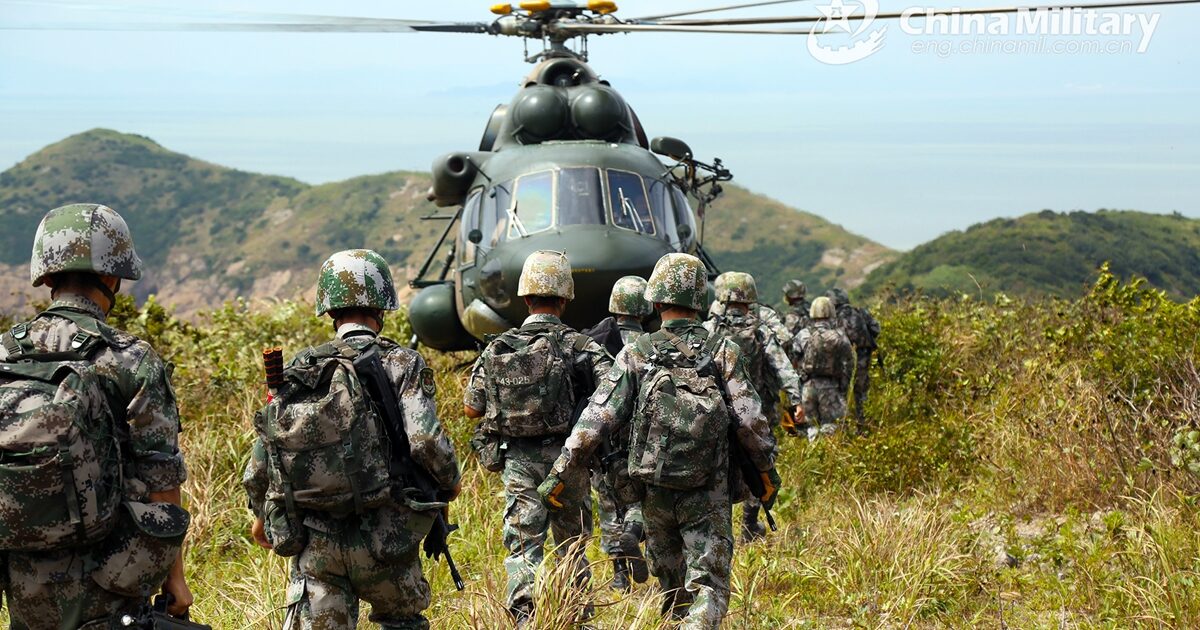Soldiers assigned to an army aviation brigade under the PLA 72nd Group Army queue to board a Mi-171 transport helicopter (eng.chinamil.com.cn/Photo by Zhang Huanpeng).
The US-China Economic and Security Review Commission has released its 2025 annual report, warning Congress that Beijing is expanding its global influence through a coordinated strategy that challenges the US-led democratic order across every major domain. The 728-page bipartisan report describes a comprehensive threat.
China is using economic coercion, supply-chain dominance, military modernization, rapid advances in space and emerging technologies, and governance and influence campaigns to reshape the international system on terms favorable to the Chinese Communist Party.
According to the report, a China-dominated world order would be marked by weaponized interdependence, state surveillance, coercive control over global norms, and dramatically reduced global stability, security, and freedom.
The Commission highlights China’s drive toward military superiority. Over the past year, the PLA expanded its nuclear warhead stockpile, deployed new amphibious assault ships and stealth fighter jets, built out its drone capacity, and conducted unprecedented naval live-fire exercises in the Tasman Sea near Australia and New Zealand. These upgrades, combined with Beijing’s investments in artificial intelligence, quantum computing, hypersonic weapons, and mobile amphibious platforms, have reduced the warning time the United States or Taiwan would have before a Chinese attack.
PLA incursions into Taiwan’s air defense identification zone increased from just 20 in 2019 to 3,075 in 2024. US and Taiwan military officials now warn that China could implement a blockade within hours and would need only minimal preparation time before attempting a full invasion.
The report stresses that China’s support for Russia, Iran, and North Korea has created an informal axis of autocratic powers, with Beijing serving as the diplomatic and economic center. China provides Russia with political cover, dual-use goods, and funding to sustain its war in Ukraine, helping Moscow evade US and international sanctions. China-Russia trade has risen 66.7 percent since 2021.
Beijing buys 90 percent of Iran’s exported oil, generating revenue equivalent to nearly the entire Iranian government budget, while funding Iran’s terrorist proxies. China also supplies North Korea with diplomatic protection and material support that advances Pyongyang’s weapons and cyber programs. These relationships allow each country to act in ways they could not sustain alone, all aimed at weakening US global leadership.
China’s regional push is most acute in Southeast Asia and the Pacific Islands. Beijing views regional economic and military hegemony as essential to undermining US power in the Indo-Pacific. China has intensified coercive actions to enforce control over the South China Sea, with the Philippines facing the harshest pressure despite being a US treaty ally.
Chinese criminal networks operating massive scam-center compounds across Southeast Asia, responsible for tens of billions of dollars in illicit revenue and at least $5 billion in losses for Americans in 2024, have also become a pretext for China to expand its security footprint in the region. Through this “inside-out” strategy, China seeks to infiltrate internal security systems of regional governments, giving Beijing leverage to influence their foreign-policy decisions.
The Commission warns that China has embarked on a whole-of-government campaign to become the world’s dominant space power. Beijing views space as a warfighting domain and has rapidly developed advanced launch capabilities, satellites, and ground infrastructure designed to degrade, damage, or destroy US satellites. Over the past decade, China has launched satellites at an aggressive pace, building systems capable of persistent surveillance, targeting US forces, and threatening the satellites that underpin America’s command-and-control networks.
China’s economic and supply-chain power remains a central pillar of its strategy. The report warns that Beijing is on track to break its own record trade surplus in 2025, creating a new “China Shock” that floods global markets with cheap goods and destroys manufacturing jobs across emerging economies.
Energy-sector vulnerabilities are also deepening. China supplies more than half of US imports of battery-storage systems and low-voltage transformers, embedding Chinese components throughout the American power grid at a time when PRC-sponsored Volt Typhoon cyber actors have already pre-positioned assets inside US critical infrastructure.
Beijing has weaponized supply-chain dependencies by leveraging its rare-earth processing monopoly in negotiations with Washington and imposing export controls on critical minerals and magnets used across defense and manufacturing. China also dominates the global supply of active pharmaceutical ingredients and produces roughly half of the world’s printed circuit boards, leaving the United States exposed to catastrophic disruption if Beijing cuts access. Companies across the United States, Europe, and Asia have reported mounting delays and intrusive data demands during China’s mineral-export license reviews.
The Commission also details China’s rise as a manufacturing and innovation powerhouse. Through industrial policies such as Made in China 2025, Beijing has secured dominance over much of the legacy and advanced componentry that fuels modern consumer and enterprise technologies. Its network of “interlocking innovation flywheels” allows advances in one sector to accelerate progress in others, positioning China to outpace the United States in several critical technologies.
Hong Kong has become a hub for sanctions evasion and the illicit transfer of controlled goods to Russia, Iran, and North Korea. Hong Kong security forces have escalated transnational repression campaigns against democracy activists abroad, issuing bounties, canceling passports, and blocking access to pensions, including for Canadian citizens.
Taken together, the Commission warns that the world has entered a decisive phase in China’s campaign to impose sovereignty over Taiwan and to displace the United States as the leading diplomatic, economic, and military power. The PLA’s expanding capabilities, constant gray-zone pressure, and aggressive maneuvers in the Taiwan Strait and the South China Sea signal an ever-increasing threat from China.
The report concludes with 28 recommendations, emphasizing 10 as urgent priorities. These include creating a consolidated economic-statecraft entity to counter China’s evasion of export controls and sanctions; strengthening pharmaceutical-supply-chain resilience; establishing a national objective to build a secure bioeconomy industrial base; protecting the US power grid from vulnerabilities created by Chinese components; bolstering the Bureau of Industry and Security to manage fast-moving strategic technologies such as semiconductors; establishing a national “Quantum First” goal by 2030; increasing Space Force appropriations to secure space superiority; creating an interagency task force to combat Chinese-run scam centers; and directing the Department of Defense to assess US readiness for a Taiwan contingency.
The post New Report: Beijing Advances War, Tech, Trade, and Influence Power Across All Domains appeared first on The Gateway Pundit.











